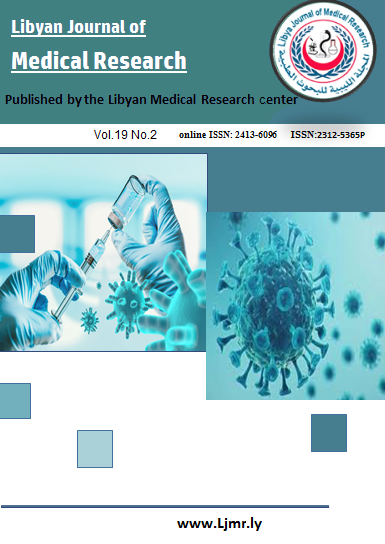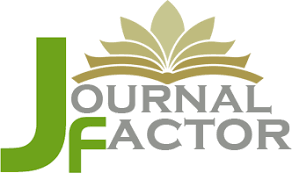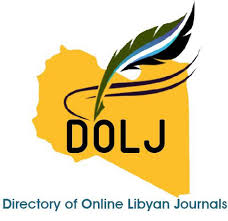Osteochondral Lesion of Talus Treated by Mosaicplasty from the Knee as Donor Site, Orthopedic Surgery Ward. Tobruk Medical Center, L
DOI:
https://doi.org/10.54361/LJMR.19.2.25Keywords:
Osteochondral Lesion, Talus, Mosaicplasty, Knee, Donor SiteAbstract
Background: Osteochondral lesions of the talus (OLT) represent a frequent cause of chronic ankle pain and disability, particularly in young and active individuals. Conservative management often provides limited benefit in advanced cases, making surgical treatment a necessary option. Mosaicplasty, which involves the transfer of autologous osteochondral grafts, has gained recognition as an effective method for restoring articular cartilage integrity. This study aimed to evaluate the clinical outcomes of mosaicplasty in patients with advanced talar dome lesions. Material and Methods: A descriptive case series was conducted at the Orthopaedic and Traumatology Department of Tobruk Medical Centre between January 2010 and December 2022. Twenty-one patients with MRI-confirmed Bristol/Hepple grade ≥3 OLT were included. The cohort consisted of 18 males and 3 females, with a mean age of 30 years (range: 20–41). Lesions were right-sided in 12 patients and left-sided in 9. Based on lesion site, 15 were anteromedial and 6 were anterolateral. Seven patients were aged 20–30, thirteen were 30–40, and one was over 41. Medial malleolar osteotomy was performed in 5 patients. Fifteen cases had a history of sports-related ankle trauma. Exclusion criteria were diabetes mellitus, neglected or chronic ankle injuries, arthritis, rheumatologic or metabolic disease, prior ankle surgery, or age above 45. The follow-up period ranged from 3 to 4 years. Results: Most patients experienced significant pain relief, improved ankle motion, and functional recovery. Outcomes were slightly better in the anteromedial group compared to anterolateral lesions. Younger patients and those with acute sports injuries achieved more favorable results. No major complications, graft failure, or severe donor site morbidity occurred. Conclusion: Mosaicplasty is a safe and effective surgical technique for advanced talar dome OLT, providing consistent pain reduction, improved joint function, and successful return to activity. Larger, long-term controlled studies are warranted to confirm these findings.
Downloads
References
1. Canale ST, Belding RH. Osteochondral lesions of the talus. J Bone Joint Surg Am. 1980;62(1):97–102.
2. Ferkel RD, Zanotti RM, Komenda GA, Sgaglione NA, Cheng MS, Applegate GR, et al. Arthroscopic treatment of chronic osteochondral lesions of the talus: long-term results. Am J Sports Med. 2008;36(9):1750–1762.
3. Kumai T, Takakura Y, Tanaka Y, Kato T, Arimoto T. Histopathological findings in osteochondral lesions of the talus. Foot Ankle Int. 2002;23(12):1101–1107.
4. Schenck RC Jr, Goodnight JM. Osteochondritis dissecans. J Bone Joint Surg Am. 1996;78(3):439–456.
5. Berndt AL, Harty M. Transchondral fractures (osteochondritis dissecans) of the talus. J Bone Joint Surg Am. 1959;41(6):988–1020.
6. Tol JL, van Dijk CN. Etiology of the osteochondral defect of the talus. Knee Surg Sports Traumatol Arthrosc. 2000;8(5):273–278.
7. Verhagen RA, Struijs PA, Bossuyt PM, van Dijk CN. Systematic review of treatment strategies for osteochondral defects of the talar dome. Foot Ankle Clin. 2003;8(2):233–242.
8. Elias I, Zoga AC, Morrison WB, Besser MP, Schweitzer ME. Osteochondral lesions of the talus: localization and morphologic classification with MRI. AJR Am J Roentgenol. 2007;188(5):1311–1319.
9. Chuckpaiwong B, Berkson EM, Theodore GH. Microfracture for osteochondral lesions of the ankle: outcome analysis and outcome predictors of 105 cases. Arthroscopy. 2008;24(1):106–112.
10. Loomer R, Fisher C, Lloyd-Smith R, Sisler J, Cooney T. Osteochondral lesions of the talus. Am J Sports Med. 1993;21(1):13–19.
11. Canale ST, Belding RH. Osteochondral lesions of the talus. J Bone Joint Surg Am. 1980;62(1):97–102.
12. Ferkel RD, Zanotti RM, Komenda GA, Sgaglione NA, Cheng MS, Applegate GR, et al. Arthroscopic treatment of chronic osteochondral lesions of the talus: long-term results. Am J Sports Med. 2008;36(9):1750–1762.
13. Kumai T, Takakura Y, Tanaka Y, Kato T, Arimoto T. Histopathological findings in osteochondral lesions of the talus. Foot Ankle Int. 2002;23(12):1101–1107.
14. Schenck RC Jr, Goodnight JM. Osteochondritis dissecans. J Bone Joint Surg Am. 1996;78(3):439–456.
15. Berndt AL, Harty M. Transchondral fractures (osteochondritis dissecans) of the talus. J Bone Joint Surg Am. 1959;41(6):988–1020.
16. Tol JL, van Dijk CN. Etiology of the osteochondral defect of the talus. Knee Surg Sports Traumatol Arthrosc. 2000;8(5):273–278.
17. Verhagen RA, Struijs PA, Bossuyt PM, van Dijk CN. Systematic review of treatment strategies for osteochondral defects of the talar dome. Foot Ankle Clin. 2003;8(2):233–242.
18. Elias I, Zoga AC, Morrison WB, Besser MP, Schweitzer ME. Osteochondral lesions of the talus: localization and morphologic classification with MRI. AJR Am J Roentgenol. 2007;188(5):1311–1319.
19. Chuckpaiwong B, Berkson EM, Theodore GH. Microfracture for osteochondral lesions of the ankle: outcome analysis and outcome predictors of 105 cases. Arthroscopy. 2008;24(1):106–112.
20. Loomer R, Fisher C, Lloyd-Smith R, Sisler J, Cooney T. Osteochondral lesions of the talus. Am J Sports Med. 1993;21(1):13–19.
21. Murawski CD, Kennedy JG. Operative treatment of osteochondral lesions of the talus. J Bone Joint Surg Am. 2013;95(11):1045–1054.
22. Scranton PE Jr, McDermott JE. Treatment of type V osteochondral talar dome lesions using autogenous cancellous bone graft. Foot Ankle Int. 2001;22(5):380–384.
23. Fraser EJ, Sugimoto D, Miyamoto RG, Micheli LJ, Kocher MS. Osteochondral autograft transplantation for lesions of the talus: a systematic review. Knee Surg Sports Traumatol Arthrosc. 2016;24(4):1249–1259.
24. Hangody L, Kish G, Karpati Z, Szerb I, Udvarhelyi I. Mosaicplasty for the treatment of osteochondritis dissecans of the talus: a multicenter study. Orthopedics. 2001;24(8):733–736.
25. Hangody L, Fules P. Autologous osteochondral mosaicplasty for the treatment of full-thickness defects of weight-bearing joints: ten years of experimental and clinical experience. J Bone Joint Surg Am. 2003;85 Suppl 2:25–32.
26. Hangody L, Kish G, Karpati Z. Mosaicplasty for the treatment of osteochondral defects of the talus: technique and early results. Foot Ankle Clin. 2003;8(2):309–322.
27. Al-Shaikh RA, Chou LB, Mann JA, Dreeben SM. Autologous osteochondral grafting for talar cartilage defects. Foot Ankle Int. 2002;23(5):381–389.
28. Gracitelli GC, Meric G, Briggs DT, Fresh osteochondral allografts in the knee: comparison of primary and revision procedures. Am J Sports Med. 2015;43(4):885–891.
29. Kreuz PC, Steinwachs MR, Erggelet C, Krause SJ, Konrad G, Uhl M, et al. Results after microfracture of full-thickness chondral defects in different compartments in the knee. Osteoarthritis Cartilage. 2006;14(11):1119–1125.
20. Sabaghzadeh A, Omidi-Kashani F, Hasankhani EG, Azar M, Mazlumi M. Clinical outcomes of mosaicplasty in osteochondral lesions of the talus. Foot Ankle Surg. 2018;24(2):127–132.
21. Georgiannos D, Bisbinas I. Clinical outcomes of mosaicplasty in articular cartilage defects of the talus: a prospective study. Foot Ankle Int. 2009;30(4):332–336.
22. Sammarco GJ, Makwana NK. Treatment of talar osteochondral lesions using autologous osteochondral grafts (mosaicplasty). Foot Ankle Int. 2002;23(5):403–408.
23. Nguyen A, Beaulieu-Jones BR, Myerson CL. Osteochondral lesions of the talus: an update on surgical management. Curr Rev Musculoskelet Med. 2021;14(3):169–177.
24. Hangody L, Fules P. Autologous osteochondral mosaicplasty for the treatment of full-thickness defects of weight-bearing joints: ten years of experimental and clinical experience. J Bone Joint Surg Am. 2003;85 Suppl 2:25–32.
25. Scranton PE Jr, McDermott JE. Treatment of type V osteochondral talar dome lesions using autogenous cancellous bone graft. Foot Ankle Int. 2001;22(5):380–384.
26. Kolker D, Murray M, Wilson M. Osteochondral lesions of the talus treated with autologous osteochondral grafts: a preliminary report. J Bone Joint Surg Br. 2004;86(7):1114–1119.
27. Saxena A, Eakin C. Articular talar injuries in athletes: results of microfracture and autologous chondrocyte implantation. Foot Ankle Int. 2007;28(4):323–328.
28. Sexton SA, Tennent TD, Hinsche AF. Mosaicplasty in the treatment of osteochondral lesions of the talus. J Bone Joint Surg Br. 2001;83-B(Suppl 1):28.
29. Reddy SS, Pedowitz DI, Parekh SG, Wapner KL. Osteochondral lesions of the talus. J Am Acad Orthop Surg. 2009;17(5):269–279.
30. McGahan PJ, Pinney SJ. Current concept review: osteochondral lesions of the talus. Foot Ankle Int. 2010;31(1):90–101.
31. Gautier E, Kolker D, Jakob RP. Treatment of cartilage defects in the talus with autologous osteochondral transplantation. J Bone Joint Surg Am. 2002;84(3):488
Downloads
Published
Issue
Section
License
Copyright (c) 2025 Ebrahim Masawd Fakhri, Arhoma Yahya Mohammed, Rasha .J .Abra, Ahmed. s .mikael (Author)

This work is licensed under a Creative Commons Attribution-NonCommercial-NoDerivatives 4.0 International License.
Open Access Policy
Libyan journal of medical Research (LJMR).is an open journal, therefore there are no fees required for downloading any publication from the journal website by authors, readers, and institution.
The journal applies the license of CC BY (a Creative Commons Attribution 4.0 International license). This license allows authors to keep ownership f the copyright of their papers. But this license permits any user to download , print out, extract, reuse, archive, and distribute the article, so long as appropriate credit is given to the authors and the source of the work.
The license ensures that the article will be available as widely as possible and that the article can be included in any scientific archive.
Editorial Policy
The publication of an article in a peer reviewed journal is an essential model for Libyan journal of medical Research (LJMR). It is necessary to agree upon standards of expected ethical behavior for all parties involved in the act of publishing: the author, the journal editorial, the peer reviewer and the publisher.
Any manuscript or substantial parts of it, submitted to the journal must not be under consideration by any other journal. In general, the manuscript should not have already been published in any journal or other citable form, although it may have been deposited on a preprint server. Authors are required to ensure that no material submitted as part of a manuscript infringes existing copyrights, or the rights of a third party.
Authorship Policy
The manuscript authorship should be limited to those who have made a significant contribution and intellectual input to the research submitted to the journal, including design, performance, interpretation of the reported study, and writing the manuscript. All those who have made significant contributions should be listed as co-authors.
Others who have participated in certain substantive aspects of the manuscript but without intellectual input should only be recognized in the acknowledgements section of the manuscript. Also, one of the authors should be selected as the corresponding author to communicate with the journal and approve the final version of the manuscript for publication in the LJMR.
Peer-review Policy
- All the manuscripts submitted to LJMR will be subjected to the double-blinded peer-review process;
- The manuscript will be reviewed by two suitable experts in the respective subject area.
- Reports of all the reviewers will be considered while deciding on acceptance/revision or rejection of a manuscript.
- Editor-In-Chief will make the final decision, based on the reviewer’s comments.
- Editor-In-Chief can ask one or more advisory board members for their suggestions upon a manuscript, before making the final decision.
- Associate editor and review editors provide administrative support to maintain the integrity of the peer-review process.
- In case, authors challenge the editor’s negative decision with suitable arguments, the manuscript can be sent to one more reviewer and the final decision will be made based upon his recommendations.












